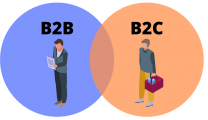The dark age
Yet despite this evidence, creativity in advertising appeared to be declining since the last financial recession.
A 2016 study authored by Peter Field for the IPA and advertising service WARC found the number of short-term campaigns (those campaigns focusing on sales activation) had quadrupled to 30%, while budget investment behind creativity fell by around 12 percentage points.
The impact was that brand building effects declined for the first time, and the SoV efficiency multiplier fell in the years following 2010.
Long-term, fully-funded campaigns were as effective as ever, but there were fewer of them being made.
And the effectiveness of creatively-awarded campaigns fell to its lowest level in 24 years as the marketing industry increasingly shifted to more short-term campaigns, as Field found and documented in his second report for the IPA, The Crisis in Creative Effectiveness.
“Historically, creativity has been the single most important tool we can harness to boost effectiveness,” says the report.
“The evidence of this link has been very strong, with enormous effectiveness multipliers evident for the most creative campaigns. So it really matters that this link is now critically weakened and perhaps broken.”
Given all the data that shows the difference creativity can make, why the lack of investment by brands?
There are many answers to this question. Some cite procurement and finance’s growing demand for measurable marketing spend. Others say that difficult economic conditions tend to result in companies becoming safer and more risk-averse. This evidence was accentuated by the Great Recession of 2008/2009.

Still, others put the blame mostly on the rise of Digital Marketing. The rise of digital over the past 10 years has led to a focus on performance and optimization over creativity.
It is seen as easier and cheaper to improve SEO than try to come up with an awareness-creating brand campaign.
A new renaissance
However, there is evidence that creativity is rising up the agenda again – and it looks like the recent Covid-19 crisis has accentuated this new phase.
“Are we one the verge of a right brain reset?” ask Orlando Wood on his recent essay, “What Should Ads Look Like in the Time of Recession?” published by LinkedIn’s B2B Institute.
The only way to stand out from the crowd is to be creative. If that peak really has been reached, the marketing industry will be forced to refocus on creativity.
Yet marketers and their counterparts in finance have become used to the measurability of performance marketing.
If the industry can’t prove the effectiveness of creativity, brands will continue to up spend on short-term sales activations rather than brand building. The majority of marketers are trying to add some science to the art.
Adding science to art
Which brings us to the concept of content experience.
The perfect content experience is where marketing science and creativity meet. It’s where data and performance blend with creativity and emotions.
According to MarTech Advisor, who coined the term, the content experience is defined as “the overall experience of accessing, consuming, engaging with and responding to a stream of branded content — across diverse devices, platforms and channels, and throughout the buyer’s journey, from prospect to customer”.
Chitra Iyer, editor-in-chief of MarTech Advisor, said: “Prospects and customers don’t look to consume an individual piece of content, but rather are on a journey where they need ongoing resources to help move purposefully forward in their buying decision”.
The case for creative content experience
Creativity drives entertaining, emotional, and beautiful content experiences.
Content should have relevant, emotional messages that are full of branding but should be easy to consume at the same time. Think about interactive content or online videos: both are entertaining, can be emotional, and provide data and insights.
Interactive content adds some science to the art. In fact, it is one of the most engaging content types; it’s a valid technique for both brand awareness and activation/lead gen.
It generates customer insights. It represents an entertaining and emotional element of the content experience.
Vitor Peçanha, co-founder of Rock Content, writes: “In marketing, every time we interact with a piece of content, we are also living experience: the satisfaction of learning something new, the comfort of being well informed of a decision, etc.”.
Peçanha breaks down what a content experience truly is and compares it to the experience of visiting a Disney park. Disney knows what they’re doing. They know how to create a memorable experience for their guests.
Content experiences may not have the same cross-generational impact that a Disney experience has. However, they can still give visitors a sense of belonging, whimsy, and most importantly remain in their memories.
In marketing, every time we interact with a piece of content, we are also living experience: the satisfaction of learning something new, the comfort of being well informed of a decision.
Vitor Peçanha
A content experience is a combination of content and context. Every piece of content conveys an experience through elements like creative design, placement, environment, and more.
And it’s not just about creativity. Think about personalization. Your customers live in a world of Spotify and Netflix.
The expectation of personalized content experiences has been set. B2B marketers need to adapt to buyer expectations. Those who do will win over customers by recognizing each individual and providing personalized experiences based on their unique interests, behaviors, and needs.
A content experience is, therefore, about addressing the whole user experience when engaging with the content. It puts control back in the hands of the marketer, while also focusing on the brand experience.

Content Marketing and content experience
For those who have been working with Content Marketing for years, the content experience isn’t really a new revolutionary idea.
Are content experience and Content Marketing the same thing? The short answer is no. Content Marketing & content experience differ for two main reasons.
First, unlike Content Marketing, content experience considers how people consume and interact with your content.
So the focus is not just the content on the page; it’s how you package and design content. It’s how you deliver and recommend content in more meaningful ways from the first touch to the sale and beyond.
The genesis of the content experience approach is an understanding that, as per Chitra Iyer of MarTech Advisor, “Prospects and customers don’t look to consume an individual piece of content, but rather are on a journey where they need ongoing resources to help move purposefully forward in their buying decision”.
Creativity is the second element of differentiation for a content experience. Content Marketing generally aims at informing and educating readers; creativity is not part of the mix.
It is instead a critical element of content experience. Exceptional creative design helps content make a business impact and gain effectiveness, exactly like it does with creative advertising.
Conclusions
While offline marketing allowed brands to create and maintain positive mental and physical associations (long-term brand building), online marketing used to be restricted to monetizing the brand equity created somewhere else (short-term activation).
Unfortunately, the online marketing/advert industry reinforced this perception with an obsessive focus on performance marketing and lower-funnel goals of receiving an immediate return on investment (efficiency over effectiveness).
Things have changed: content experiences, a blend of old and new content formats, creative design, and emotional storytelling are entertaining, emotional, and provide data and insights.












Replies to This Discussion